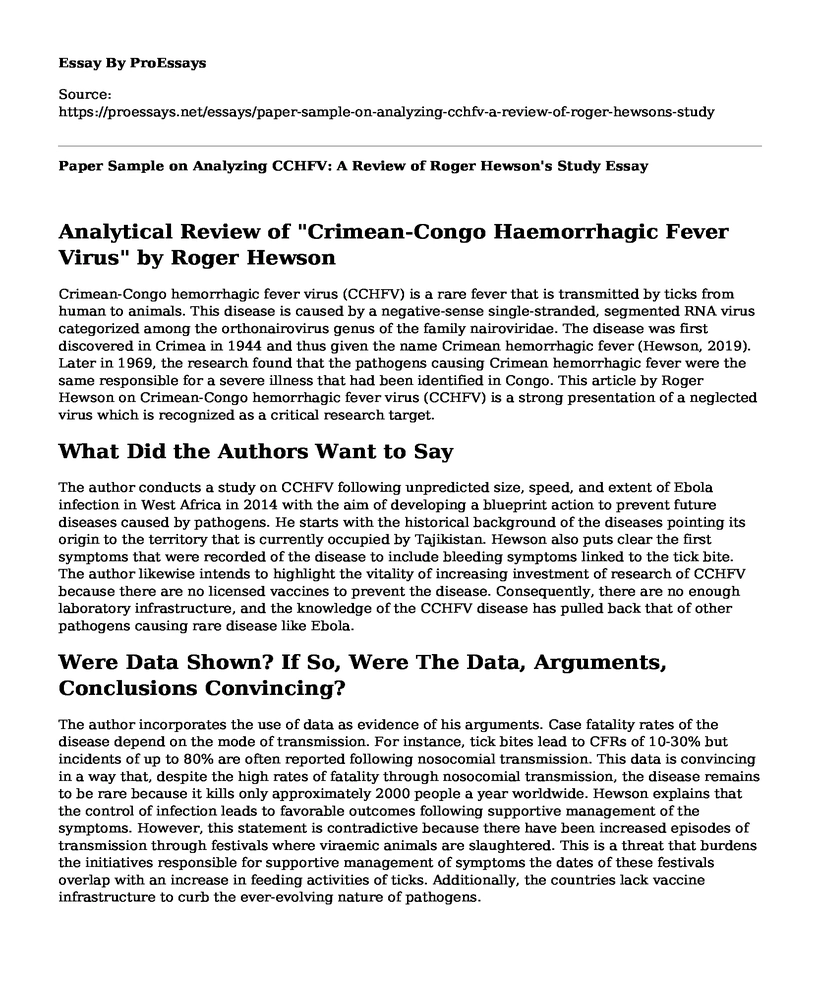Analytical Review of "Crimean-Congo Haemorrhagic Fever Virus" by Roger Hewson
Crimean-Congo hemorrhagic fever virus (CCHFV) is a rare fever that is transmitted by ticks from human to animals. This disease is caused by a negative-sense single-stranded, segmented RNA virus categorized among the orthonairovirus genus of the family nairoviridae. The disease was first discovered in Crimea in 1944 and thus given the name Crimean hemorrhagic fever (Hewson, 2019). Later in 1969, the research found that the pathogens causing Crimean hemorrhagic fever were the same responsible for a severe illness that had been identified in Congo. This article by Roger Hewson on Crimean-Congo hemorrhagic fever virus (CCHFV) is a strong presentation of a neglected virus which is recognized as a critical research target.
What Did the Authors Want to Say
The author conducts a study on CCHFV following unpredicted size, speed, and extent of Ebola infection in West Africa in 2014 with the aim of developing a blueprint action to prevent future diseases caused by pathogens. He starts with the historical background of the diseases pointing its origin to the territory that is currently occupied by Tajikistan. Hewson also puts clear the first symptoms that were recorded of the disease to include bleeding symptoms linked to the tick bite. The author likewise intends to highlight the vitality of increasing investment of research of CCHFV because there are no licensed vaccines to prevent the disease. Consequently, there are no enough laboratory infrastructure, and the knowledge of the CCHFV disease has pulled back that of other pathogens causing rare disease like Ebola.
Were Data Shown? If So, Were The Data, Arguments, Conclusions Convincing?
The author incorporates the use of data as evidence of his arguments. Case fatality rates of the disease depend on the mode of transmission. For instance, tick bites lead to CFRs of 10-30% but incidents of up to 80% are often reported following nosocomial transmission. This data is convincing in a way that, despite the high rates of fatality through nosocomial transmission, the disease remains to be rare because it kills only approximately 2000 people a year worldwide. Hewson explains that the control of infection leads to favorable outcomes following supportive management of the symptoms. However, this statement is contradictive because there have been increased episodes of transmission through festivals where viraemic animals are slaughtered. This is a threat that burdens the initiatives responsible for supportive management of symptoms the dates of these festivals overlap with an increase in feeding activities of ticks. Additionally, the countries lack vaccine infrastructure to curb the ever-evolving nature of pathogens.
Are There Any Weak Spots in The Authors' Approach, Experimental Design & Conclusions? If Yes...Which One(S)?
There are no major weak points of experimental designs used by the author. According to Hewson, molecular methods based on partial and complete sequence data of the S-segment have been used to identify certain types of S-segment genotypes. The experimental design is convincing since research has shown that these genotypes present a strong connection to the physical area of isolation of the parent virus, leading to the terminology. One weak spot offers when the author strongly recommends the use of a highly modified vaccinia Ankara approach that drives the expression of CCHFV-GP. A weak point presents here because pathogens evolve into more resistant strains that can lead to the development of new diseases, yet the first trials of the method are intended to commence in 2020.
Was The Article's Message Strong and Convincing?
In conclusion, the message of the article is strong and convincing from the history of the development of the virus to its spread. The author uses accurate data and description of symptoms to present evidence about the disease. Also, the article message is strong in a way that through the study of the history of development to current active research, there is a higher chance of emergence of more improved approaches.
References
Hewson, R. (2019, August 19). Crimean-Congo haemorrhagic fever virus. Arboviruses and their Vectors, 112-115. Retrieved from https://microbiologysociety.org/publication/current-issue/arboviruses-and-their-vectors.html
Cite this page
Paper Sample on Analyzing CCHFV: A Review of Roger Hewson's Study. (2023, Feb 11). Retrieved from https://proessays.net/essays/paper-sample-on-analyzing-cchfv-a-review-of-roger-hewsons-study
If you are the original author of this essay and no longer wish to have it published on the ProEssays website, please click below to request its removal:
- Health Disparities in Mississippi Essay
- Essay on Osteoporosis in Aging
- Research Paper on Ebola Disease
- Smokers With COPD That Are Oxygen Dependent - Essay Sample
- Essay Sample on Cerebrovascular & Coronary Artery Disease: Causes & Effects
- Essay on 33% Assault on Native American Women: Unreported Deaths
- Essay Sample on EHR: Improve Quality, Safety & Efficiency in Health Care







